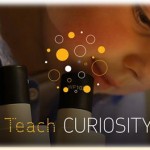I came across this picture and began thinking about the word CURIOSITY….
CURIOSITY is “a spirit of inquiry” or “a wish to learn and know.” I was the student in class that was CURIOUS about everything. I had the D2L (Desire to Learn) and still do. I seek out blogs, read, research, and attend workshops/conferences. CURIOSITY is that desire to want to know more and to find/research information that is your passion. It is what drives the innovation and creativity of ones desires. CURIOSITY is the desire to find out about the world around us, and our place in it; a craving for knowledge or the need to understand what surrounds us. I think most of us are born with a strong sense of curiosity, but how that stays with us depends a lot on the people around us. I’m one of the lucky ones who’s been surrounded by people who encouraged this sense of wonder, so I never lost it.
I wonder, “What is that?” “What’s its purpose?” and “How does it work?” What can we as teachers do to help encourage our students’ curiosity?
1. Act as a facilitator. Helping students explore opportunities to discover personal understanding aides them in owning educational experiences. It is good for students to LEARN, LEAD, and CONNECT.
2. Think of the classroom as a learning lab, and organize activities and lessons accordingly. Experimenting with a wide range of experiences increases future learning across subject areas. EXPLORE, ENGAGE, and EXPERIMENT.
3. Encourage student-created questions to develop higher-order thinking. Allowing students to analyze situations and determine multiple solutions increases problem-solving abilities.
4. Develop collaborative work groups in which students explore solutions as a team. Helping students to learn from one another and defend their point of view to peers develops confidence, as well as critical thinking skills.
5. Provide hands-on activities and promote independent research using readily available materials. Developing perseverance through trial and error gives students a sense of how hypotheses become theories.
6. Integrate the free use of technology for study and research. (BYOD, iTouches, iPads, Google Tvs, Laptops, Computers, Nooks, Kindles….etc.)

